First And Final Warning Letter Template
[Your Name]
[Your Title/Position]
[Company Name]
[Company Address]
[City, State, ZIP Code]
[Date]
[Recipient's Name]
[Recipient's Title/Position]
[Department/Division Name]
[Company Name]
[Company Address]
[City, State, ZIP Code]
Subject: First and Final Warning Letter
Dear [Recipient's Name],
I hope this letter finds you well. It is with great concern that I address the issues that have come to our attention regarding your performance and conduct at [Company Name]. As an organization, we strive to maintain high standards of professionalism and productivity, and it is essential that all employees contribute positively to the success of the company.
The purpose of this letter is to formally bring to your attention the following areas of concern:
1. Performance Issues: Over the past [time period], there have been noticeable instances of subpar performance in your role. These issues include [specific examples of performance issues, e.g., missed deadlines, errors in work, decreased productivity].
2. Conduct Concerns: Additionally, we have received reports about your behavior that do not align with the expected standards of conduct at our company. This includes [specific examples of conduct concerns, e.g., unprofessional language, inappropriate behavior with colleagues, violation of company policies].
We believe in providing our employees with ample opportunities to improve their performance and behavior. Therefore, this letter serves as a first and final warning. You are hereby informed that unless there is a significant and sustained improvement in your performance and conduct within the next [specified timeframe, e.g., 30 days], further disciplinary action, up to and including termination of employment, may be taken.
We understand that various factors may be affecting your performance, and we encourage you to discuss any challenges you are facing with your immediate supervisor or the HR department. Our priority is to support our employees in achieving their best potential and overcoming any obstacles they may encounter.
To assist you in your improvement, we have outlined the following steps:
1. A meeting will be scheduled with your immediate supervisor and the HR department to discuss the specific areas of concern in detail and to offer any necessary guidance or resources.
2. A performance improvement plan (PIP) will be developed, outlining the expectations for improvement and the timeframe within which progress will be evaluated.
3. You will be encouraged to seek assistance or training in areas where improvement is needed, and we will explore possibilities for mentorship or coaching if appropriate.
4. Regular follow-up meetings will be conducted to monitor your progress and provide feedback and support.
Please be aware that the company reserves the right to take further action if there is no satisfactory improvement within the specified timeframe. We genuinely hope that this warning will motivate you to make the necessary changes and become a valuable and contributing member of our team.
We believe that you have the potential to grow and succeed, and we are committed to helping you achieve that. However, your active participation and dedication to improvement are crucial.
This letter is an official document and will be placed in your employee file for future reference.
If you have any questions or concerns regarding this letter or the steps outlined above, please feel free to contact me or the HR department at your convenience.
Sincerely,
[Your Name]
[Your Title/Position]
[Company Name]
First Warning Letter for Attendance Issue
Subject: First Warning Regarding Attendance
Dear [Employee Name],
This letter serves as a formal first warning concerning your attendance record. It has been noted that you have been absent without prior notice on multiple occasions, specifically on [list dates].
Consistent attendance is critical for the smooth functioning of our team. Please treat this letter as a formal notice to improve your attendance immediately. Further infractions may result in a final warning or additional disciplinary action.
We expect your full cooperation and commitment to improving your attendance.
Sincerely,
[Your Name]
[Position]
Final Warning Letter for Performance Issue
Subject: Final Warning Regarding Job Performance
Dear [Employee Name],
This letter serves as a final warning regarding your unsatisfactory job performance. Despite prior counseling and the issuance of a first warning on [date], your performance has not met the required standards.
Immediate and sustained improvement is expected. Failure to demonstrate measurable improvement may result in termination of employment. Please take this matter seriously and discuss any support you may require with your supervisor.
Sincerely,
[Your Name]
[Position]
First Warning Letter for Misconduct
Subject: First Warning for Misconduct
Dear [Employee Name],
This is to formally notify you of a first warning regarding inappropriate conduct observed on [date]. Your actions, specifically [describe behavior], are not in accordance with company policies.
You are expected to correct your behavior immediately. Further incidents will result in stricter disciplinary measures, including a final warning. Please consider this letter a formal notice to adhere to company standards.
Sincerely,
[Your Name]
[Position]
Final Warning Letter for Repeated Misconduct
Subject: Final Warning Regarding Misconduct
Dear [Employee Name],
Following previous warnings dated [list dates], it has come to our attention that you have again engaged in misconduct, specifically [describe behavior]. This letter serves as your final warning.
Immediate corrective action is required. Failure to comply may lead to termination of employment. We urge you to take this warning seriously and adhere strictly to company policies.
Sincerely,
[Your Name]
[Position]
First Warning Letter for Tardiness
Subject: First Warning for Tardiness
Dear [Employee Name],
This letter is issued as a first warning regarding your repeated tardiness. Records indicate that you have arrived late on [list dates].
Punctuality is essential for team productivity and maintaining workplace standards. Please ensure that you adhere to your scheduled working hours. Further incidents may result in a final warning or additional disciplinary measures.
Sincerely,
[Your Name]
[Position]
Final Warning Letter for Policy Violation
Subject: Final Warning Regarding Policy Violation
Dear [Employee Name],
Despite prior discussions and a first warning issued on [date], you have again violated company policies, specifically [describe policy violation]. This is your final warning.
You are required to comply with all company policies immediately. Continued non-compliance may result in termination of employment. Please acknowledge receipt of this letter and take corrective measures without delay.
Sincerely,
[Your Name]
[Position]
First Warning Letter for Poor Work Quality
Subject: First Warning Concerning Work Quality
Dear [Employee Name],
This letter serves as a first warning regarding the quality of your work. Specifically, your recent projects on [list projects or tasks] have not met the required standards.
You are expected to improve your performance immediately. Your supervisor will provide guidance and support to help you meet expected standards. Continued substandard work may result in a final warning.
Sincerely,
[Your Name]
[Position]
What / Why: Understanding First and Final Warning Letters
First and final warning letters are formal notices issued to employees to address performance, behavior, or policy violations.
- Purpose includes:
- Notifying employees of unsatisfactory conduct or performance
- Offering an opportunity for improvement
- Establishing documentation for potential future disciplinary actions
- Maintaining organizational standards and accountability
Who Should Send a First and Final Warning Letter
- Supervisors or immediate managers
- Human Resources (HR) personnel
- Department heads or senior management for serious issues
- Official company representatives with authority to issue disciplinary notices
Whom These Letters Should Be Addressed To
- Employees demonstrating repeated misconduct or policy violations
- Staff with ongoing performance or attendance issues
- Team members whose actions negatively impact productivity or workplace standards
When to Issue First and Final Warning Letters
- After observing repeated or serious misconduct
- Following poor performance despite coaching or feedback
- For attendance or punctuality issues
- When company policies or codes of conduct are violated
- As part of documented disciplinary procedures before termination
How to Prepare and Send These Letters
- Review documentation of the employee's behavior or performance
- Clearly specify the issue with dates and examples
- Outline prior warnings or counseling (for final warnings)
- State expectations for improvement and consequences of non-compliance
- Choose the appropriate mode: printed letter or email with acknowledgment
- Keep a copy in the employee’s HR file
Elements and Structure of a First and Final Warning Letter
- Subject line clearly stating "First Warning" or "Final Warning"
- Greeting with the employee’s name
- Description of issue or violation
- Reference to prior warnings or discussions (for final warning)
- Expectations for improvement and corrective actions
- Consequences of further infractions
- Closing with signature of authorized personnel
Formatting and Tone Guidelines
- Length: concise, usually one page
- Tone: professional, formal, and serious
- Wording: clear, precise, and unambiguous
- Style: official letter format with date and signature
- Mode: printed and hand-delivered or sent via official company email
- Etiquette: respectful while emphasizing accountability
Requirements and Prerequisites Before Issuing
- Evidence of misconduct, poor performance, or policy violation
- Record of prior verbal warnings or coaching sessions
- HR guidelines and legal compliance review
- Approval from supervisors or department heads if necessary
- Employee’s job description and performance standards for reference
Pros and Cons of Issuing Warning Letters
Pros:
- Provides formal documentation of issues
- Offers the employee a chance to correct behavior
- Establishes a legal record for potential termination
- Encourages accountability and standard adherence
Cons:
- May negatively affect employee morale
- Risk of disputes if documentation is insufficient
- Time-consuming to prepare and follow up
Tricks and Tips for Effective Warning Letters
- Include specific examples and dates
- Keep language professional and factual
- Clearly state expectations and consequences
- Follow up with a meeting to discuss the letter
- Maintain copies for HR records
- Avoid emotional language; focus on actions and policies
Common Mistakes to Avoid
- Using vague or ambiguous language
- Failing to document prior verbal warnings
- Overlooking HR or legal guidelines
- Issuing without prior counseling (unless egregious)
- Ignoring tone—avoid language that may seem threatening or aggressive
FAQ About First and Final Warning Letters
Q: Can a first warning be verbal instead of written?
A: Yes, verbal warnings can precede written first warnings, but documentation is recommended.
Q: Is a final warning always followed by termination?
A: Not always, but it is a final opportunity for improvement before serious disciplinary action.
Q: Can these letters be issued via email?
A: Yes, but ensure acknowledgment and documentation are obtained.
Q: How long should an employee have to improve after a warning?
A: Typically defined by company policy, often ranging from 30 to 90 days depending on the issue.
Compare and Contrast With Other Disciplinary Actions
- Versus Verbal Warning: Written warnings provide formal documentation; verbal warnings are informal and less binding.
- Versus Suspension: Warnings are preventive; suspension is punitive.
- Versus Termination: Warnings precede termination to offer a chance for improvement.
- Versus Performance Improvement Plan (PIP): Warnings are shorter formal notices, while PIPs are detailed programs with measurable goals.

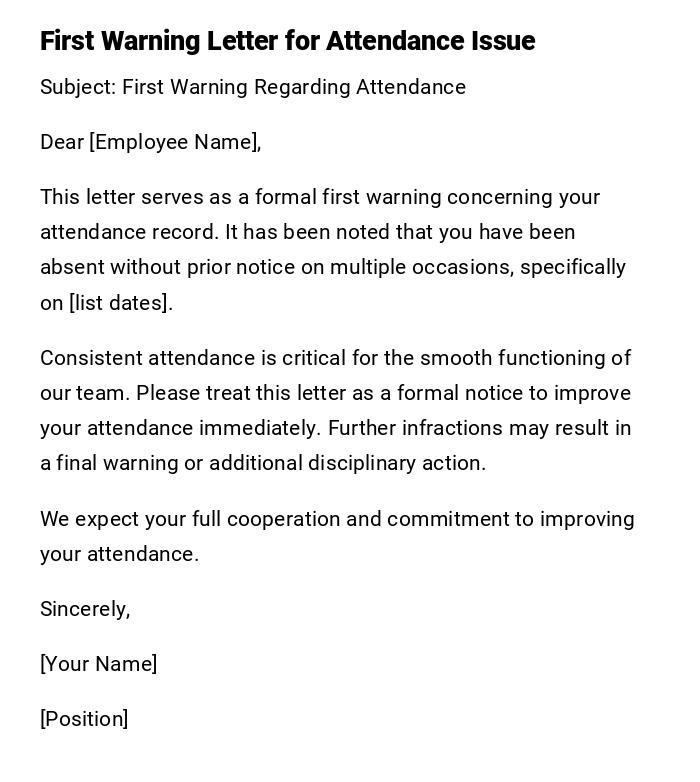
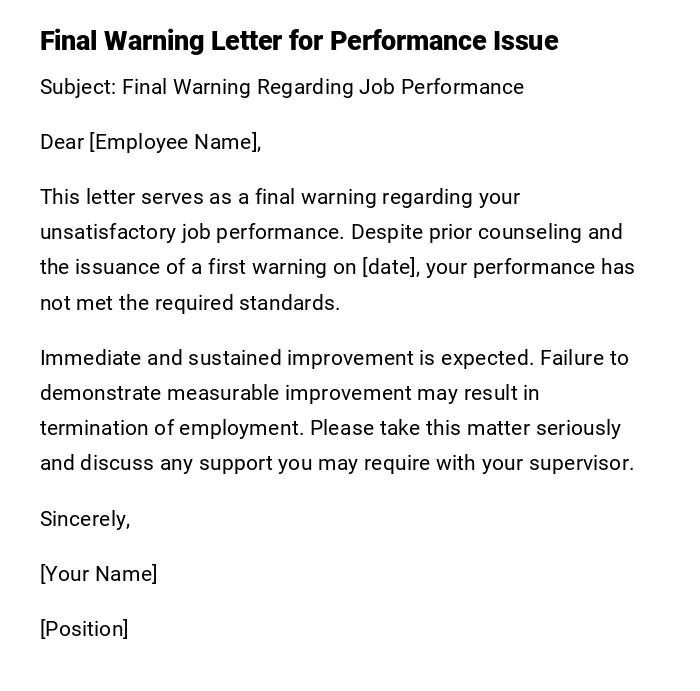
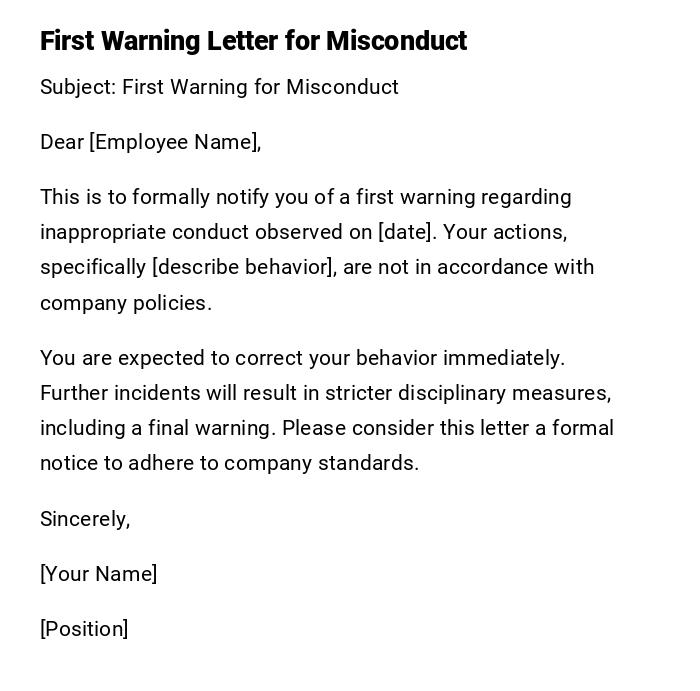
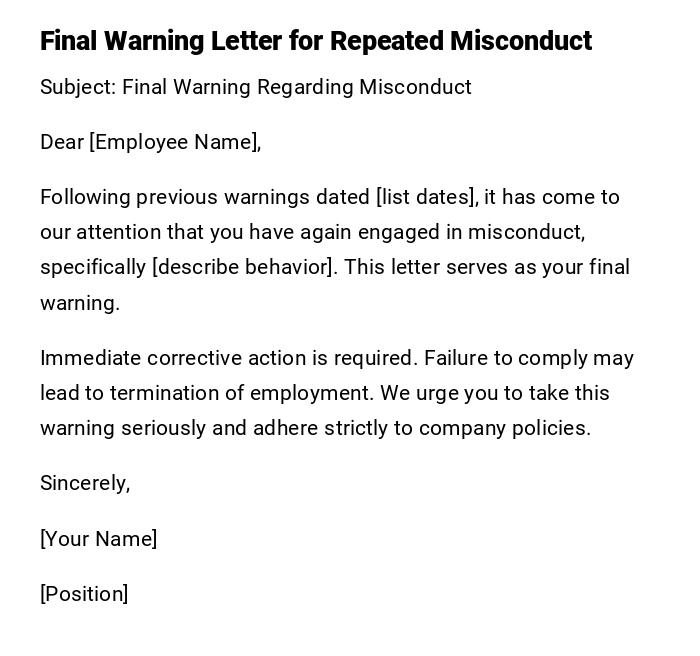
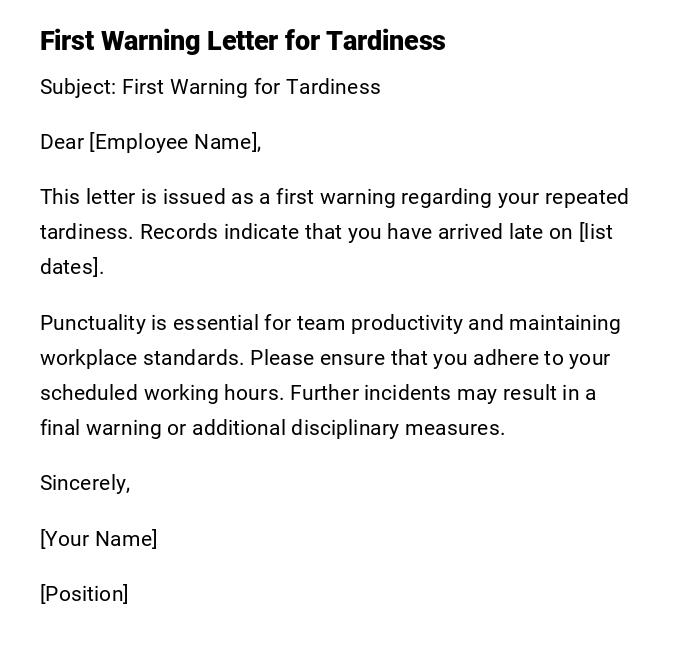

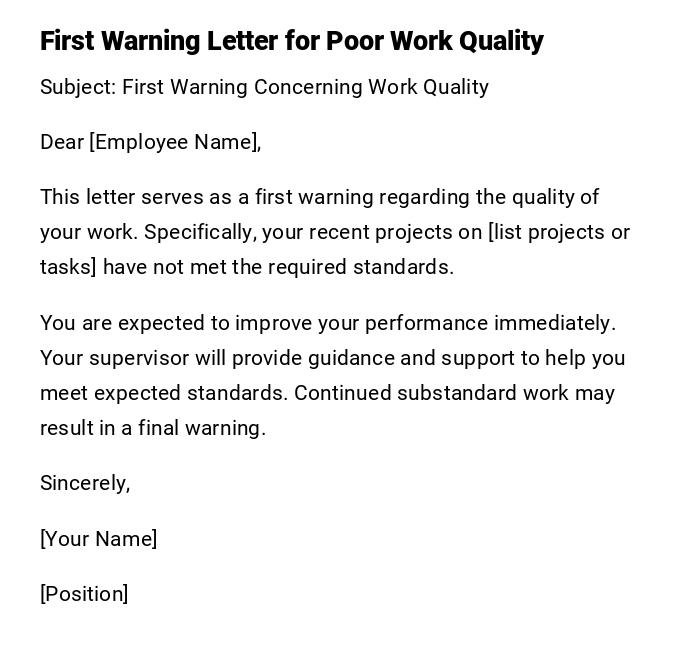

 Download Word Doc
Download Word Doc
 Download PDF
Download PDF